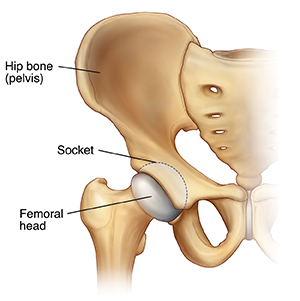Understanding Minimally Invasive Total Hip Replacement
Total hip replacement is surgery to replace a damaged hip joint. Minimally invasive surgery uses 1 or more small cuts (incisions) instead of a single large incision. The procedure is done by an orthopedic surgeon. This is a doctor with special training in treating bone, joint, and muscle problems.
About the hip joint
Each hip joint is made up of the rounded top of the thighbone (femoral head) sitting in a curved area (hip socket) in the pelvic bone. The joint is lined with a flexible cushion (cartilage). Normally, the femoral head moves smoothly in the hip socket. When you have joint damage, the cartilage that normally lines the joint wears away. The bones no longer move smoothly. This causes pain. During a total hip replacement, the femoral head and the hip socket are replaced.

Why is minimally invasive total hip replacement done?
You may need this surgery if you have severe damage to your hip joint. This can cause pain and interfere with your daily activities. Conditions that may damage this joint include:
-
Osteoarthritis. Also called wear-and-tear arthritis. The cartilage wears away as a person ages. This is the most common cause of damage.
-
Rheumatoid arthritis. This is a type of arthritis that affects not only joints but the whole body. Serious joint damage may occur if it’s not treated.
-
Osteonecrosis. This is damage caused by decreased blood supply to a bone.
-
Injury. This may be a break (fracture).
-
Tumor. This is an abnormal growth of the bone. It may or may not be cancer.
Total hip replacement may help lessen your pain and make it easier to move your hip. It also improves your quality of life. Hip replacement is typically advised only if other treatments haven’t worked.
How is minimally invasive total hip replacement done?
The surgery is done by an orthopedic surgeon. This is a surgeon who specializes in treating bone, muscle, joint, and tendon problems. The surgery can be done in several ways. The surgeon makes 1 or more small cuts through the skin and muscles near the hip. They take the femoral head out of the joint socket. The surgeon replaces the femoral head with a metal or ceramic one. They remove damaged cartilage and bone from the joint socket. The surgeon puts a metal cup into the socket. Screws may be used to hold it in place. The surgeon places the femoral head back in the socket.
What are the risks of minimally invasive total hip replacement?
All surgeries have some risks. The risks of this surgery include:
-
Infection
-
Bleeding
-
Blood clots
-
Injury to nerves
-
Artificial joint getting out of position (dislocation)
-
Loosening of the hip joint
-
One leg that is slightly shorter or longer
-
Problems from anesthesia
Your risks vary based on your age and general health. For example, if you are a smoker or if you have low bone density, you may have a higher risk of certain problems. People with diabetes may also have a higher risk for problems. Ask your surgeon which risks apply most to you.
Online Medical Reviewer:
Raymond Turley Jr PA-C
Online Medical Reviewer:
Stacey Wojcik MBA BSN RN
Online Medical Reviewer:
Thomas N Joseph MD
Date Last Reviewed:
5/1/2022
© 2000-2024 The StayWell Company, LLC. All rights reserved. This information is not intended as a substitute for professional medical care. Always follow your healthcare professional's instructions.